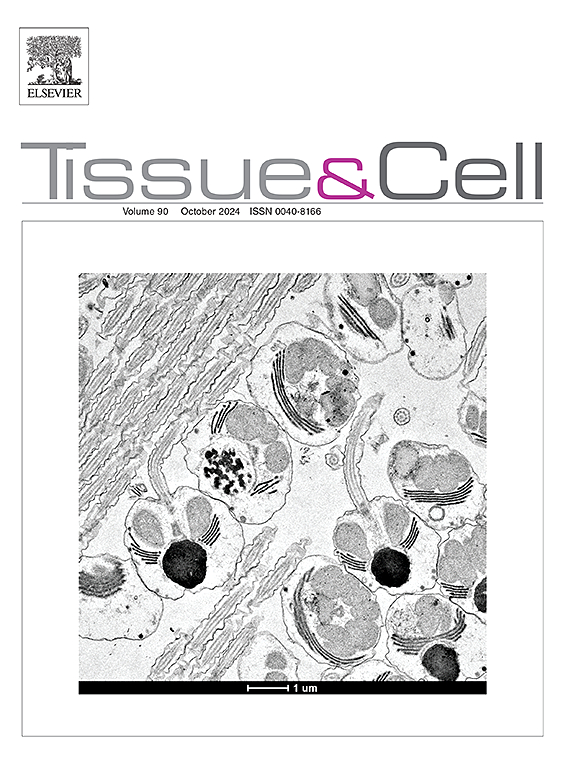Ginsenoside Rk1 inhibits the malignant progression of lung cancer by inactivating the INSR/PI3K/AKT pathway
IF 2.7
4区 生物学
Q1 ANATOMY & MORPHOLOGY
引用次数: 0
Abstract
Background
Lung cancer continues to be a primary contributor to global cancer deaths. The urgent need for effective therapeutic interventions has led researchers to explore natural compounds with potential anti-cancer properties. Ginsenoside Rk1 (Rk1), a pharmacologically active component derived from ginseng, has garnered attention for its reported anti-cancer effects, however, the molecular mechanisms underlying its action against lung cancer remain poorly elucidated.
Methods
This study employed a series of in vitro assays, including cell counting kit-8, cell colony formation, 5-Ethynyl-2’-deoxyuridine, flow cytometry, and Transwell assays, to assess the effects of Rk1 on lung cancer cell viability, proliferation, apoptosis, migration, and invasion. Western blotting, immunohistochemistry assay, and quantitative real-time polymerase chain reaction were used to evaluate the protein and mRNA expression, respectively. Bioinformatics tools such as Genecards, Swiss Target Prediction, and Cytoscape 3.9.1 were utilized for network pharmacological analysis and pathway mapping. The interaction between Rk1 and INSR was analyzed using a cellular thermal shift assay. Animal experiment was performed to validate the effect of Rk1 and INSR overexpression on the malignant progression of lung cancer cells.
Results
Rk1 treatment significantly inhibited lung cancer cell proliferation, migration, and invasion, while inducing cell apoptosis and autophagy. Importantly, we identified insulin receptor (INSR) as a pivotal target of Rk1. Notably, INSR expression was found to be upregulated in lung cancer tissues and cells. In addition, Rk1 treatment heat-stabilized INSR and reduced its protein expression in A549 cells. Depletion of INSR mimicked the inhibitory effects of Rk1, whereas overexpression of INSR mitigated these effects. Furthermore, Rk1 inactivated the PI3K/AKT pathway through the regulation of INSR. Further, INSR overexpression attenuated Rk1 treatment-induced inhibitory effect on the malignant progression of lung cancer cells.
Conclusion
This study provided novel insights into the molecular mechanisms by which Rk1 exerted its anti-cancer effects in lung cancer, specifically through targeting the INSR/PI3K/AKT pathway. These findings not only contributed to the understanding of Rk1’s therapeutic potential but also offered a rationale for its further development as a promising therapeutic agent for the treatment of lung cancer. The identification of INSR as a key target represents a significant advancement in the field, highlighting the importance of natural compounds in modern cancer therapy.
背景肺癌仍然是全球癌症死亡的主要原因。对有效治疗干预措施的迫切需求促使研究人员探索具有潜在抗癌特性的天然化合物。人参皂苷 Rk1(Rk1)是从人参中提取的一种药理活性成分,因其抗癌作用而备受关注。本研究采用了一系列体外检测方法,包括细胞计数试剂盒-8、细胞集落形成、5-乙炔基-2'-脱氧尿苷、流式细胞术和 Transwell 检测法,以评估 Rk1 对肺癌细胞活力、增殖、凋亡、迁移和侵袭的影响。Western 印迹、免疫组化和定量实时聚合酶链反应分别用于评估蛋白质和 mRNA 的表达。利用Genecards、Swiss Target Prediction和Cytoscape 3.9.1等生物信息学工具进行网络药理学分析和通路图绘制。利用细胞热转移试验分析了 Rk1 和 INSR 之间的相互作用。结果Rk1处理能显著抑制肺癌细胞的增殖、迁移和侵袭,同时诱导细胞凋亡和自噬。重要的是,我们发现胰岛素受体(INSR)是 Rk1 的关键靶点。值得注意的是,INSR 在肺癌组织和细胞中表达上调。此外,Rk1 处理可热稳定 INSR 并降低其在 A549 细胞中的蛋白表达。INSR的消耗模拟了Rk1的抑制作用,而INSR的过表达则减轻了这些作用。此外,Rk1 通过调节 INSR 使 PI3K/AKT 通路失活。结论 本研究为 Rk1 在肺癌中发挥抗癌作用(特别是通过靶向 INSR/PI3K/AKT 通路)的分子机制提供了新的见解。这些发现不仅有助于人们了解 Rk1 的治疗潜力,还为进一步开发 Rk1 作为治疗肺癌的药物提供了理论依据。将 INSR 识别为关键靶点代表了该领域的重大进展,凸显了天然化合物在现代癌症治疗中的重要性。
本文章由计算机程序翻译,如有差异,请以英文原文为准。
求助全文
约1分钟内获得全文
求助全文
来源期刊

Tissue & cell
医学-解剖学与形态学
CiteScore
3.90
自引率
0.00%
发文量
234
期刊介绍:
Tissue and Cell is devoted to original research on the organization of cells, subcellular and extracellular components at all levels, including the grouping and interrelations of cells in tissues and organs. The journal encourages submission of ultrastructural studies that provide novel insights into structure, function and physiology of cells and tissues, in health and disease. Bioengineering and stem cells studies focused on the description of morphological and/or histological data are also welcomed.
Studies investigating the effect of compounds and/or substances on structure of cells and tissues are generally outside the scope of this journal. For consideration, studies should contain a clear rationale on the use of (a) given substance(s), have a compelling morphological and structural focus and present novel incremental findings from previous literature.
 求助内容:
求助内容: 应助结果提醒方式:
应助结果提醒方式:


